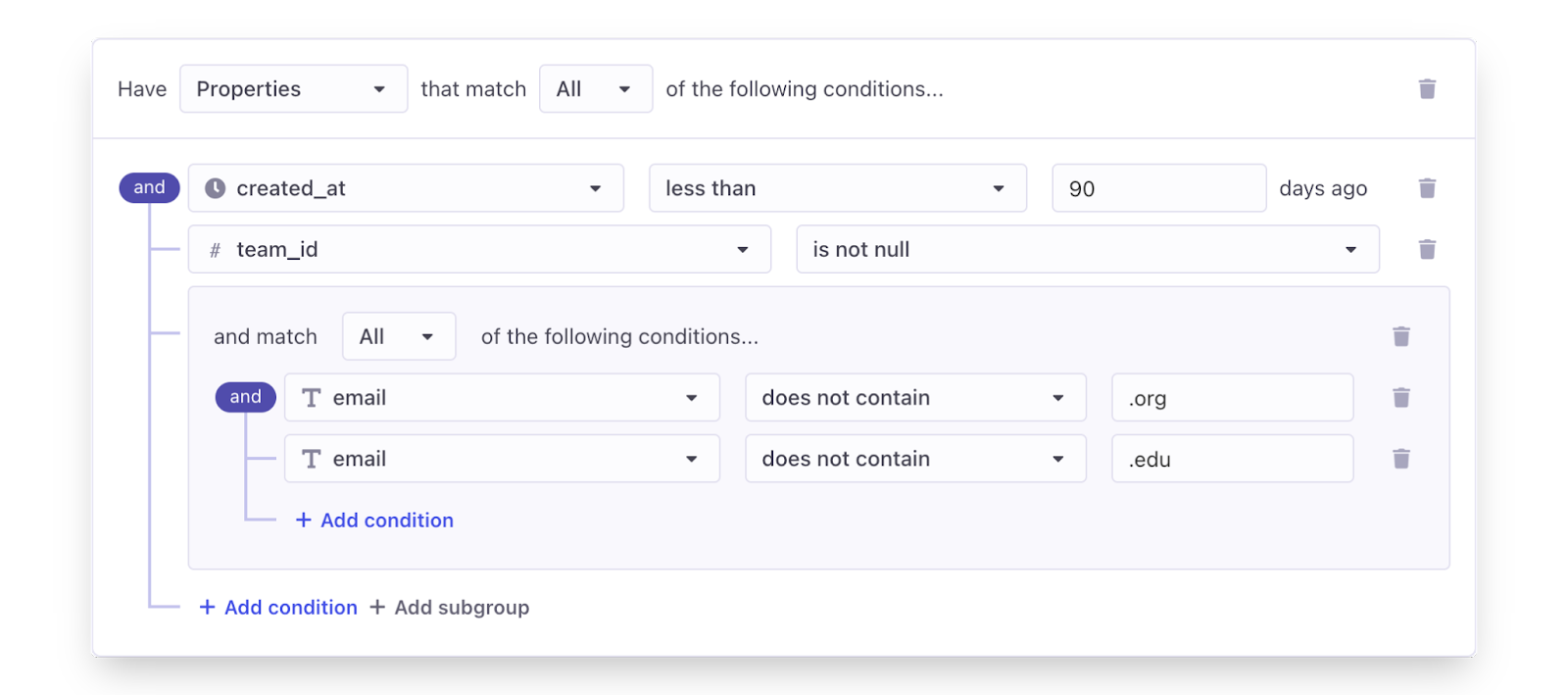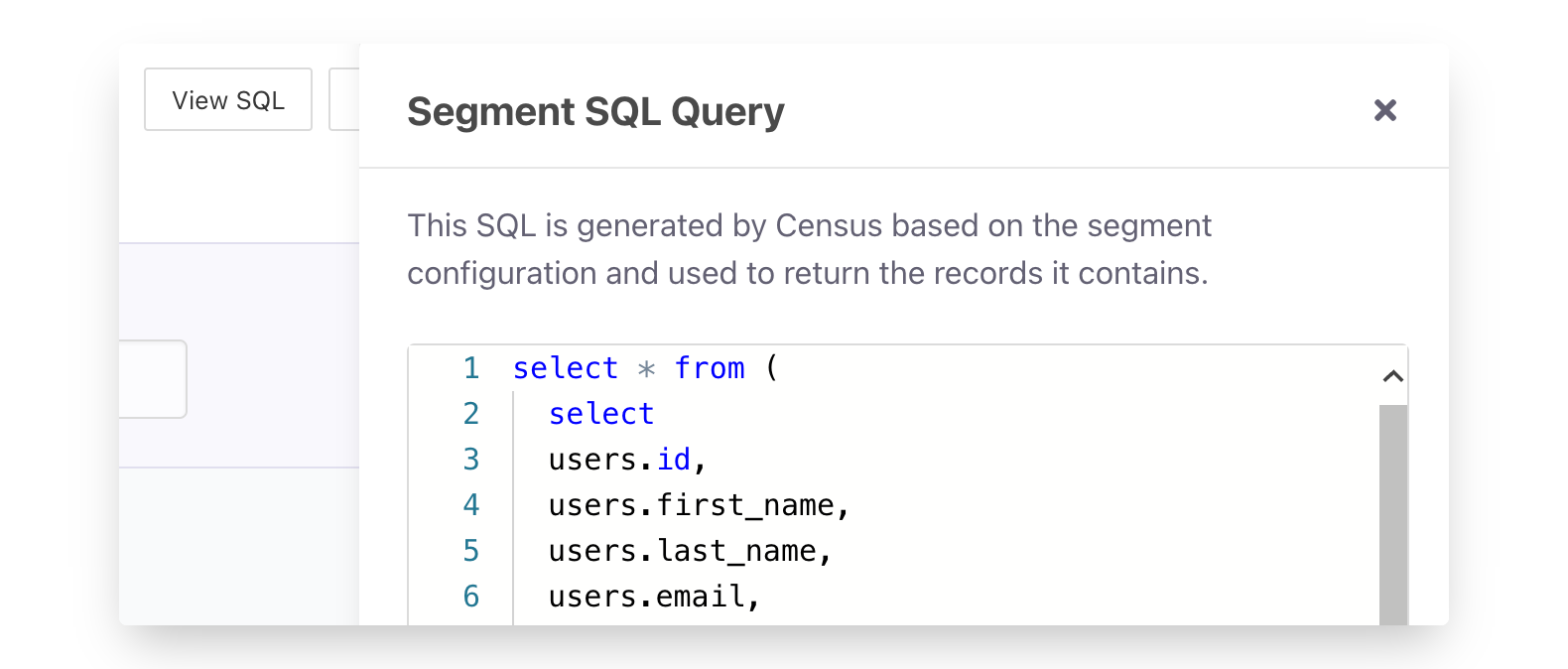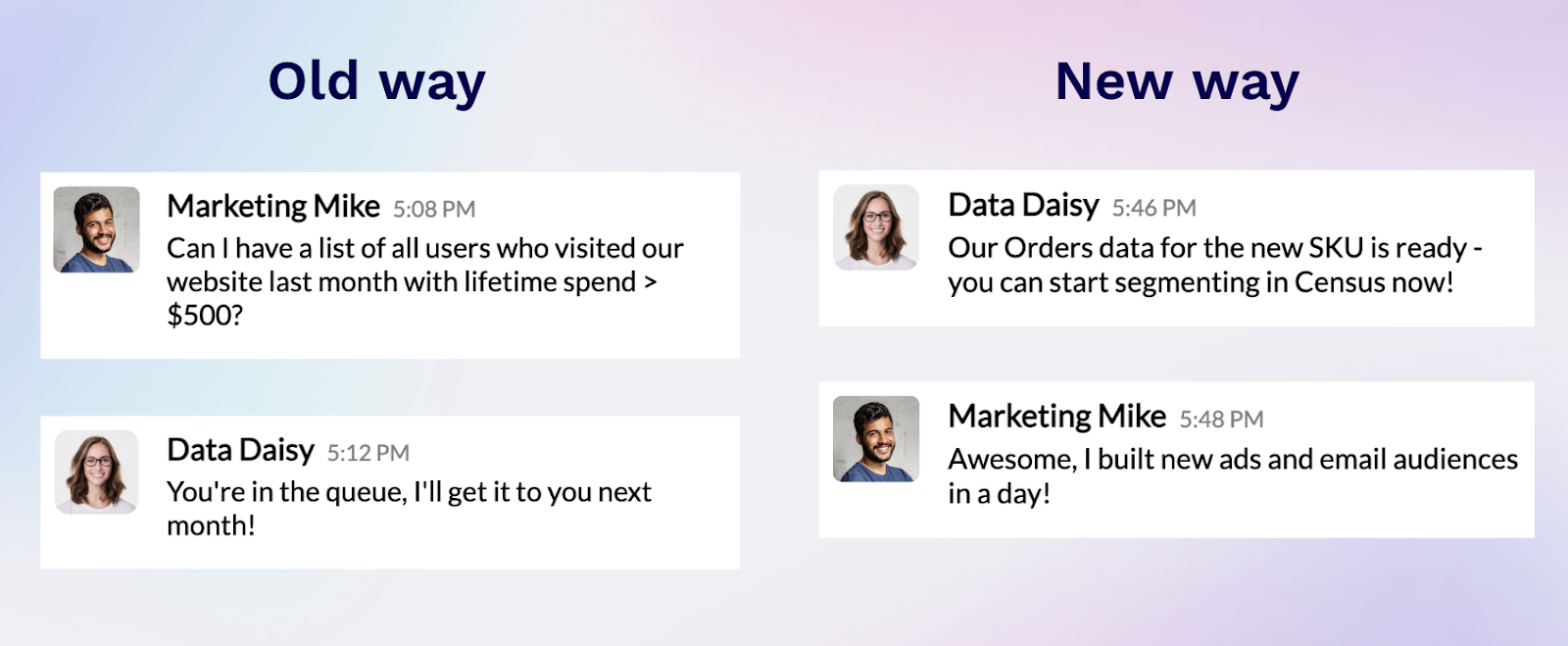ℹ️ Census Segments is now part of Audience Hub, our suite of features purpose-built to help marketers activate the 360° data in their warehouse. Check out the Audience Hub page for our newest releases!
In a digital world where personalization is expected, a one-size-fits-all approach is no longer enough. Segmenting your target market is essential to entice the right audience with the right message.
Marketers want to iterate on messaging and experiment quickly, but they’re often slowed down by fragmented information spread across multiple tools, lack of data access, and manual data uploads.
We believe the traditional martech stack actively prevents marketers from doing their best work. Data activation solves these challenges by sitting on top of the source of truth that already exists in the data warehouse.
Today, we’re excited to announce the latest version of Census Segments, which includes brand new visual segmentation. It’s the easiest way for marketers to keep their audiences fresh, with no code and no SQL. Marketers can now build dynamic segments defined across related objects and events, and sync audiences to any advertising or marketing tool from a single place.
All on top of the rich, trusted data in the warehouse, approved by data teams.
Data activation: The easiest way for marketers to leverage data

Census’s data activation platform enables marketers to unlock data directly from the warehouse – without needing analytics skills. We provide one single platform for marketers to view 360° customer data, build complex segmentation logic, and send those audiences to all their tools.
Now you can spend more time experimenting, and less time uploading. With Census Segments, marketers of any technical skill level can:
1. Operationalize first-party data without code
Instantly unlock the power of your first-party data without SQL or reliance on engineering. Build complex segments across multiple objects and event relationships, backed by the 360° customer data in your warehouse.
2. Segment and activate in a single place
Build a segment and send it to any advertising or marketing platform in one single workflow. Automated syncs keep all your tools up-to-date with the freshest data. Users are added and removed automatically as they meet criteria like clicks, pageviews, and payments.
3. Turn ideas into action in seconds, not weeks
Create segments and syncs with just a few clicks and power your existing marketing tools with the best data. Get your lookalike audiences and personalized campaigns into production faster, and iterate quickly. No more CSV uploads!
Census Segments: How they work

Census Segments lets anyone take advantage of the power of the data warehouse to create complex and expressive conditions on your company’s complete set of data, without ever having to know any SQL.
Check out this video walkthrough of how to get started with Segments:
You can easily spin up segments to:
- Target highly engaged users with specific personalized campaigns
- Identify users in key moments of the user journey just after signing up or at risk of churning
- Explore your target market and segment sizes, now that you have access to all your warehouse data points
Segments build on top of Entities, allowing you to rapidly slice-and-dice and build subsets of your data. Users can quickly point-and-click to filter on text, boolean values, dates and times, and more. Even advanced data warehouse types such as arrays can be matched. Quickly combine different conditions to filter to the exact set of data you need to target.

And because segmentation is built on top of your entities, your segment conditions can take advantage of relationships between entities too. Create segments of users that work for companies in specific geographies, or have a subscription created in the last year by navigating and defining conditions on related objects. Census automatically takes care of writing the appropriate SQL joins underneath the covers.
Event segmentation is even more powerful now, allowing you to specify combinations of event names, engagement depth, and time windows, all in addition to all the other property conditions available otherwise. Now you can target users as soon as they’ve taken the “aha moment” action and make sure they get the right message from all your marketing and advertising campaigns.
As you build segments, Census automatically recalculates the size of your audience so you can quickly see how additional conditions affect the size. Everything you build gets converted into SQL and runs automatically (Want to verify your query? Double check it!)

👉 Read the documentation for more in-depth information.
What you can do with Census Segments
Census helps marketers at every organization hyper-personalize outreach at scale. When you have access to all the sales, marketing, support, and billing data in your warehouse, you can create the most granular segments with the freshest data.
Even better, your dynamic segments will automatically change as your data changes, ensuring that your audiences are always up-to-date.
Here are a few common use cases that are even more efficient and effective with Census Segments:
Winback campaigns: Easily filter across multiple attributes like lifetime spend or subscription status, plus events like purchases and email clicks. Build segments of high-value customers who haven’t purchased recently, and target them with personalized campaigns to re-engage them.
Exclusion lists: Set up dynamic suppression audiences so once a user has purchased a product or installed your app, they’ll no longer be targeted with those offers. Avoid spending advertising budgets on the wrong users and increase conversion rates and ROAS.
Lookalike audiences: Build audiences of your best existing customers and sync them to advertising platforms like Facebook and Google to automatically find similar audiences. Lookalike audiences are a safe and cost-effective way to both expand and improve the quality of your advertising.
Omnichannel marketing: Use multiple channels like social media, email, and SMS to reach your customers wherever they’re shopping. Census makes it easy to build a segment once and sync that audience across all your channels.
Our vision: Bridging the gap between marketing and data teams 🤝
We’re building the first warehouse-native data activation platform to bring marketing and data teams together.
Other data activation tools like Customer Data Platforms (CDPs) don’t have the full picture of the customer and are costly and slow to implement.
The data warehouse is the best single source of truth for customer data – data that can help marketing teams do their job better and faster – if only they could access it.
Our goal is to empower collaboration between marketing and data teams and enable full self-service data access and data governance on the same source of truth.

For marketing teams, Census is the easiest way to activate the complete customer data in the warehouse. Marketers can build audiences and sync customer attributes to all their marketing tools without engineering.
For data teams, Census is the fastest way to activate data on top of existing infrastructure. Data teams can enable business users to sync trusted data from the warehouse to any business tool with reverse ETL, and self-serve data through a no-code UI.
For everyone, Census makes the single source of truth of customer data accessible across the entire business to empower everyone to take the next best action.
Get a demo or try for free today!
Frequently Asked Questions
How do Segments work with Access Controls?
Segments follow the same role-based access permissions that exist today, and Segments created in a workspace will only be visible to members of that workspace. Owners and Editors can create and edit all syncs and Segments. Operators can create and edit syncs as long as they're associated with Segments. Viewers have read-only access.
Are Segments available for all plans?
Core plans will have access to basic one object segments. The Platform plan has access to advanced segmentation with multi-object segments.
How is Census different from what Customer Data Platforms (CDPs) offer?
CDPs are often used by marketing teams but they weren’t built to be warehouse-native, which means they don’t have all the data you need and they quickly get expensive as you scale. We believe the best business outcomes are achieved when the data warehouse is the single source of truth for all business and data teams.
Want to learn more about when to use a CDP vs reverse ETL? Check out how The Best CDP Solution Is Already Sitting In Your Data Warehouse.

















